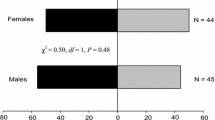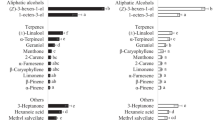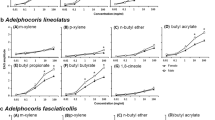Abstract
The alfalfa seed chalcid (ASC),Bruchophagus roddi, is a monophagous pest of alfalfa that parasitizes developing seeds. To further understand the olfactory basis of host-plant recognition by ASCs, we recorded electroantennograms (EAGs) from females and males to 39 volatiles from both alfalfa and red clover. The chemoreceptive sensitivity of ASCs was selective for certain general classes of compounds, defined by their carbon-chain length (C6 and C8), structure (aliphatics and phenolics), isomerism, and/or functional group (acetates, ketones, and alcohols). The compounds that elicited the largest EAGs were ranked as follows: (Z)-3-hexenyl acetate > hexyl acetate ≥ acetophenone ≥ octan-3-one ≥ methyl salicylate > octan-3-ol > oct-1-en-3-one > oct-1-en-3-ol ≥ (E)-β-ocimene ≥ (Z)- and (E)-3-hexen-1-ols. Over half the test compounds elicited significantly different responses between the sexes, and female antennal responses exceeded those of males for twice the number of these volatiles. Relationships of the tested volatiles to host-plant composition, EAG responses, and ASC behaviors showed no consistent correlations. However, nearly all of the host-plant volatiles known to stimulate behavioral activity also elicited moderate to potent EAG responses.
Similar content being viewed by others
References
Boeckh, J., Kaissling, K.-E., andSchneider, D. 1965. Insect olfactory receptors.Cold Springs Harbor Symp. Quant. Biol. 30:263–280.
Buttery, R.G. 1981. Vegetable and fruit flavors, pp. 175–216,in R. Teranishi, R.A. Flath, and H. Sugisawa (eds., Flavor Research, Recent Advances. Marcel Dekker, New York.
Buttery, R.G., andKamm, J.A. 1980. Volatile components of alfalfa: Possible insect host plant attractants.J. Agric. Food Chem. 28:978–981.
Buttery, R.G., Kamm, J.A., andLing, L.C. 1982. Volatile components of alfalfa flowers and pods.J. Agric. Food Chem. 30:739–742.
Buttery, R.G., Kamm, J.A., andLing, L.C. 1984. Volatile components of red clover leaves, flowers and seed pods: Possible insect attractants.J. Agric. Food Chem. 32:254–256.
Dickens, J.C. 1984. Olfaction in the boll weevil,Anthonomus grandis Boh. (Coleoptera: Curculionidae): Electroantennogram studies.J. Chem. Ecol. 10:1759–1785.
Dickens, J.C., andBoldt, P.E. 1985. Electroantennogram responses ofTrirhabda bacharides (Weber) (Coleoptera: Chrysomelidae) to plant volatiles.J. Chem. Ecol. 11:767–779.
Dickens, J.C., Jang, E.B., Light, D.M., andAlford, A.R., 1990. Enhancement of insect pheromone responses by green leaf volatiles.Naturwissenschaften 77:29–31.
Dumpert, K. 1972. Alarmstoffrezeptoren auf der Antenne vonLasius filiginosus (Latr.) (Hymenoptera, Formicidae).Z. Vergl. Physiol. 76:403–425.
Kami, T. 1978. Qualitative and quantitative analyses of the essential oils of red and Ladino white clovers.J. Agric. Food Chem. 26:1194–1197.
Kami, T. 1983. Composition of the essential oil of alfalfa.J. Agric. Food Chem. 31:38–41.
Kamm, J.A. 1989. In-flight assessment of host and nonhost odors by alfalfa seed chalcid (Hymenoptera: Eurytomidae).Environ. Entomol. 18:56–60.
Kamm, J.A., andButtery, R.G. 1983. Response of the alfalfa seed chalcid,Bruchophugus roddi, to alfalfa volatiles.Entomol. Exp. Appl. 33:129–134.
Kamm, J.A., andButtery, R.G. 1986a. Response of the alfalfa and clover seed chalcids (Hymenoptera: Eurytomidae) to host plant components.Environ. Entomol. 15:1244–1249.
Kamm, J.A., andButtery, R.G. 1986b. Ovipositional behavior of the alfalfa seed chalcid (Hymenoptera: Eurytomidae) in response to volatile components of alfalfa.Environ. Entomol. 15:388–391.
Lacher, V. 1964. Elektrophysiologische Untersuchungen an Einzelnen Rezeptoren fur Geruch, Kohlendioxyd, Luftfeuchtigkeit und Temperatur auf den Antennen der Arbeitsbiene und der Drohne.Z. Vergl. Physiol. 48:587–623.
Light, D.M. 1983. Sensitivity of antennae of male and femaleIps paraconfitsus (Coleoptera: Scolytidae) to their natural aggregation pheromone and its enantiomeric components.J. Chem. Ecol. 9:561–584.
Light, D.M., andJang, E.B. 1987. Electroantennogram responses of the oriental fruit fly,Dacus dorsalis, to a spectrum of alcohol and aldehyde plant volatiles.Entomol. Exp. Appl. 45:55–64.
Light, D.M., Jang, E.B., andDickens, J.C. 1988. Electroantennogram responses of the Mediterranean fruit fly,Ceratitis capitata, to a spectrum of plant volatiles.J. Chem. Ecol. 14:159–180.
Payne, T.L. 1975. Bark beetle olfaction. III. Antennal olfactory responsiveness ofDendroctonus frontalis Zimmerman andD. brevicomis Le Conte (Coleoptera: Scolytidae) to aggregation pheromones and host tree terpene hydrocarbons.J. Chem. Ecol. 1:233–242.
Raina, A.K. 1988. Selected factors influencing neurohormonal regulation of sex pheromone production inHeliothis species.J. Chem. Ecol. 14:2063–2069.
Riddiford, L.M. 1967. trans-2-Hexenal: Mating stimulant for polyphemus moth.Science 158:139–141.
Riddiford, L.M., andWilliams, C.M. 1967. Volatile principle from oak leaves role in sex life of the polyphemus moth.Science 155:589–590.
Schreier, P. 1984. Chromatographic Studies of Biogenesis of Plant Volatiles. A. Huthig Verlag, New York.
Srinivas, S.R. 1986. Volatile constituents in alfalfa and red clover extracts, pp. 343–353,in B.M. Lawrence, B.D. Mookherjee, and B.J. Willis (eds.). Flavors and Fragrances: A World Perspective. Proceedings, 10th International Congress of Essential Oils, Washington, D.C.
Strong, F.E. 1962. Laboratory studies of the biology of the alfalfa seed chalcid,Bruchophugus roddi, Guss. (Hymenoptera: Eurytomidae).Hilgardia 32:229–249.
Tressel, R., Bahri, D., andEngel, K.-H. 1981. Lipid oxidation in fruit and vegetables, pp. 213–232,in R. Teranishi and H. Barrera-Benitez (eds.. Quality of Selected Fruits and Vegetables of North America. ACS Symposium 170. American Chemical Society, Washington, D.C.
Van Straten, S., andMaarse, H. 1983. Volatile Compounds in Food, 5th ed. Central Institute for Nutrition and Food Research TNO, Zeist, The Netherlands.
Vareschi, E. 1971. Duftunterscheidung bei der Honigbiene-Einzelzell-Arbeitung und Verhaltensreaktionen.Z. Vergl. Physiol. 75:143–173.
Visser, J.H. 1979. Electroantennogram responses of the Colorado beetle,Leptinotarsa decemlineata to plant volatiles.Entomol. Exp. Appl. 25:86–97.
Visser, J.H. 1983. Differential sensory perceptions of plant compounds by insects.Am. Chem. Soc. Symp. Ser. 208:215–230.
Visser, J.H. 1986. Host odor perception in phytophagous insects.Annu. Rev. Entomol. 31:121–144.
Visser, J.H., Van Straten, S., andMaarse, H. 1979. Isolation and identification of volatiles in the foliage of potato,Solanum tuberosum, a host plant of the Colorado beetle,Leptinotarsa decemlineata.J. Chem. Ecol. 5:13–25.
Wheeler, J.W., andDuffield, R.M. 1988. Pheromones of Hymenoptera and Isoptera, pp. 59–206,in E.D. Morgan and N.B. Mandava (eds.). CRC Handbook of Natural Pesticides, Vol IV, Pheromones, Part B. CRC Press, Boca Raton, Florida.
Author information
Authors and Affiliations
Rights and permissions
About this article
Cite this article
Light, D.M., Kamm, J.A. & Buttery, R.G. Electroantennogram response of alfalfa seed chalcid,Bruchophagus roddi (Hymenoptera: Eurytomidae) to host- and nonhost-plant volatiles. J Chem Ecol 18, 333–352 (1992). https://doi.org/10.1007/BF00994235
Received:
Accepted:
Issue Date:
DOI: https://doi.org/10.1007/BF00994235




